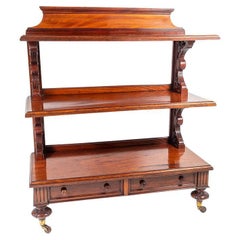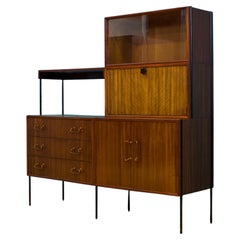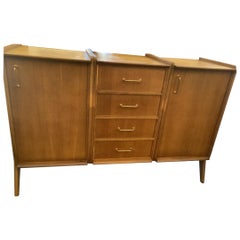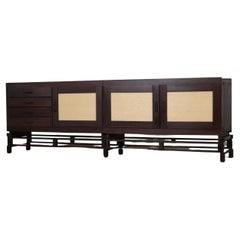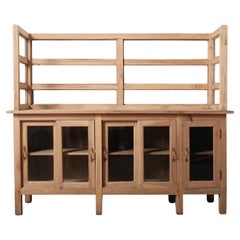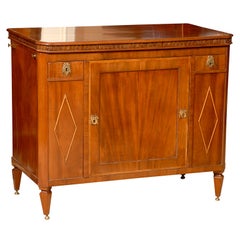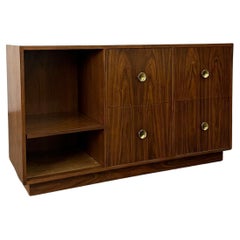Sideboard With Shelving
Antique Mid-19th Century British Victorian Shelves
Mahogany
Mid-20th Century British Mid-Century Modern Bookcases
Walnut
Mid-20th Century French Mid-Century Modern Cabinets
Oak
Vintage 1950s Sideboards
Metal
Mid-20th Century Indian Rustic Cupboards
Brass
Recent Sales
Antique 18th Century and Earlier Dutch Sideboards
Metal
Mid-20th Century American Mid-Century Modern Sideboards
Walnut
Mid-20th Century Danish Scandinavian Modern Sideboards
20th Century Organic Modern Cabinets
Wood
20th Century French Sideboards
Oak
Vintage 1960s Scandinavian Scandinavian Modern Bookcases
Teak
Vintage 1960s Swedish Scandinavian Modern Bookcases
Teak
Vintage 1960s Scandinavian Scandinavian Modern Bookcases
Teak
Vintage 1960s Dutch Mid-Century Modern Sideboards
Glass, Wood, Teak
Vintage 1950s Danish Buffets
Wood
Mid-20th Century Danish Mid-Century Modern Sideboards
Teak
Vintage 1940s French Sideboards
Mahogany
20th Century French Art Deco Sideboards
Mid-20th Century Danish Mid-Century Modern Sideboards
Teak
20th Century Norwegian Scandinavian Modern Sideboards
Rosewood
Vintage 1940s Sideboards
Wood
Antique Mid-19th Century French French Provincial Sideboards
Oak
Vintage 1930s South Asian Other Sideboards
Elm
Antique Mid-19th Century Chinese Furniture
Antique Mid-19th Century Chinese Sideboards
Wood
Antique Mid-19th Century Chinese Furniture
Wood
Vintage 1960s American Mid-Century Modern Sideboards
Stainless Steel
Vintage 1960s Danish Modern Credenzas
Mid-20th Century American Mid-Century Modern Sideboards
Marble, Steel
Mid-20th Century North American Mid-Century Modern Sideboards
Marble, Steel
Antique 19th Century English Early Victorian Dressers
Pine
Vintage 1950s Danish Mid-Century Modern Bookcases
Ash, Oak, Rosewood, Teak
Vintage 1970s American Sideboards
Late 20th Century American Mid-Century Modern Sideboards
20th Century Italian Mid-Century Modern Sideboards
Brass
Vintage 1970s Italian Mid-Century Modern Sideboards
Mahogany
Vintage 1950s Italian Mid-Century Modern Sideboards
Mahogany
Vintage 1940s French Art Deco Buffets
Walnut
20th Century American Modern Sideboards
Chrome
Mid-20th Century European Mid-Century Modern Sideboards
Teak
Vintage 1960s British Scandinavian Modern Credenzas
Mahogany
Vintage 1970s Belgian Mid-Century Modern Sideboards
Oak
Antique 18th Century and Earlier Dutch Dry Bars
Vintage 1950s Danish Buffets
21st Century and Contemporary Belgian Industrial Shelves
20th Century Danish Sideboards
Early 20th Century Chinese Sideboards
Elm
Antique 1890s Chinese Furniture
Antique 1890s Chinese Furniture
Vintage 1960s Danish Mid-Century Modern Sideboards
Walnut
Vintage 1960s Danish Sideboards
Teak
Vintage 1960s Danish Mid-Century Modern Furniture
Teak
Antique 1890s Japanese Furniture
Vintage 1960s American Sideboards
Vintage 1960s Scottish Mid-Century Modern Sideboards
Wood
20th Century American Sideboards
20th Century Danish Sideboards
Rosewood
Vintage 1950s French Sideboards
Bronze
Vintage 1940s French Sideboards
Mahogany, Parchment Paper
Antique 19th Century Chinese Furniture
Elm
Antique 19th Century Chinese Furniture
Elm, Fir
Vintage 1960s American Mid-Century Modern Credenzas
Chrome
People Also Browsed
Mid-20th Century Italian Hollywood Regency Chandeliers and Pendants
Copper
Vintage 1950s Italian Mid-Century Modern Night Stands
Glass, Wood
Antique 15th Century and Earlier African Natural Specimens
Bone
Vintage 1960s Danish Mid-Century Modern Bookcases
Brass
Vintage 1970s Italian Modern Floor Lamps
Brass
20th Century English Jacobean Dressers
Oak
Antique Early 1800s English Georgian Beds and Bed Frames
Upholstery, Mahogany
Mid-20th Century Danish Mid-Century Modern Bookcases
Rosewood
Vintage 1950s Finnish Mid-Century Modern Game Tables
Brass
Vintage 1950s Italian Mid-Century Modern Night Stands
Marble
2010s Swedish Scandinavian Modern Sideboards
Birch, Oak
21st Century and Contemporary Austrian Mid-Century Modern Floor Lamps
Brass, Iron
2010s Swedish Scandinavian Modern Sideboards
Birch, Oak
Vintage 1970s English Mid-Century Modern Night Stands
Wood, Burl
Antique 19th Century French Cupboards
Pine
Vintage 1970s Belgian Mid-Century Modern Fireplaces and Mantels
Iron
Sideboard With Shelving For Sale on 1stDibs
How Much is a Sideboard With Shelving?
Finding the Right Storage-case-pieces for You
Of all the vintage storage cabinets and antique case pieces that have become popular in modern interiors over the years, dressers, credenzas and cabinets have long been home staples, perfect for routine storage or protection of personal items.
In the mid-19th century, cabinetmakers would mimic styles originating in the Louis XIV, Louis XV and Louis XVI eras for their dressers, bookshelves and other structures, and, later, simpler, streamlined wood designs allowed these “case pieces” or “case goods” — any furnishing that is unupholstered and has some semblance of a storage component — to blend into the background of any interior.
Mid-century modern furniture enthusiasts will cite the tall modular wall units crafted in teak and other sought-after woods of the era by the likes of George Nelson, Poul Cadovius and Finn Juhl. For these highly customizable furnishings, designers of the day delivered an alternative to big, heavy bookcases by considering the use of space — and, in particular, walls — in new and innovative ways. Mid-century modern credenzas, which, long and low, evolved from tables that were built as early as the 14th century in Italy, typically have no legs or very short legs and have grown in popularity as an alluring storage option over time.
Although the name immediately invokes images of clothing, dressers were initially created in Europe for a much different purpose. This furnishing was initially a flat-surfaced, low-profile side table equipped with a few drawers — a common fixture used to dress and prepare meats in English kitchens throughout the Tudor period. The drawers served as perfect utensil storage. It wasn’t until the design made its way to North America that it became enlarged and equipped with enough space to hold clothing and cosmetics. The very history of case pieces is a testament to their versatility and well-earned place in any room.
In the spirit of positioning your case goods center stage, decluttering can now be design-minded.
A contemporary case piece with open shelving and painted wood details can prove functional as a storage unit as easily as it can a room divider. Alternatively, apothecary cabinets are charming case goods similar in size to early dressers or commodes but with uniquely sized shelving and (often numerous) drawers.
Whether you’re seeking a playful sideboard that features colored glass and metal details, an antique Italian hand-carved storage cabinet or a glass-door vitrine to store and show off your collectibles, there are options for you on 1stDibs.
- What are sideboards?1 Answer1stDibs ExpertSeptember 25, 2019
Sideboards are cabinets with shelves and drawers used to store serving utensils, dinnerware and table linens.
- What is a shelving unit?1 Answer1stDibs ExpertNovember 2, 2021A shelving unit is a flexible piece of furniture with shelves that can be rearranged to accommodate various objects such as books, collectibles, sculptures and other items for display. It can also feature dividers and can be moved or adjusted for added functionality. Shop a collection of antique and vintage shelving units and shelves on 1stDibs.
- 1stDibs ExpertMarch 13, 2024The purpose of a sideboard is to provide a place to store and organize items for the home. Often used in dining rooms, sideboards work well for keeping serveware and dinnerware free of dust and hidden when not in use. Some people use sideboards to house entertainment centers, media, games and other odds and ends in living rooms, or place them in entryways to provide places to stash cold-weather accessories, bags and shoes. Explore a large collection of sideboards on 1stDibs.
- What is a kitchen sideboard?1 Answer1stDibs ExpertAugust 17, 2021A kitchen sideboard is a piece of furniture used for serving food and storing serving dishes and table linens. Kitchen sideboards long and often sit low to the ground. Shop vintage sideboards on 1stDibs.
- 1stDibs ExpertFebruary 22, 2021Storage shelves need to be large enough to properly and safely hold items but not too large that items will get lost or hidden behind each other. In a garage 12” is a good depth for smaller items and 16” for larger items.
- 1stDibs ExpertSeptember 23, 2024What a desk with shelves is called depends on its design. A desk that features integrated shelving is usually referred to as a credenza. A separate detachable shelving unit that accompanies a desk is a hutch. Explore a wide variety of antique, vintage and contemporary desks on 1stDibs.
- 1stDibs ExpertFebruary 22, 2021There are several ways to mount floating shelves. The best mounting options include using floating shelf brackets, installing cleats, or placing figure eights.
- 1stDibs ExpertSeptember 25, 2019
The terms buffet and sideboard are used interchangeably, although buffets generally have higher legs and stand 34 to 38 inches tall.
- 1stDibs ExpertMarch 25, 2024What you can use instead of a sideboard depends on your specific needs. If you're looking for a place to set up buffet spreads when entertaining guests, a console table may be a good option. For storing or displaying items in the dining room, try a bar cabinet, hutch, bookshelf or floating wall shelves. On 1stDibs, shop a large selection of dining room furniture.
- 1stDibs ExpertSeptember 28, 2021A sideboard table is generally used for storing cutlery, napkins and other dining supplies. Sideboards have much in common with credenzas and buffet tables but they are distinct from both of those other kinds of case pieces. Shop a range of antique and vintage sideboards and other storage furniture on 1stDibs.
- 1stDibs ExpertNovember 2, 2021The difference between a sideboard and a server mostly pertains to usage. A sideboard is a side-table with cabinet doors that is used for serving, most often in a dining room (today, sideboards can sometimes be found in living rooms and foyers). In form, a credenza has much in common with a sideboard. Sideboards have short legs or no legs at all. A server is very slim and is meant to be placed along the dining room wall. It is shorter and takes up less room than a sideboard and is also considered to be more formal than a sideboard — a sideboard might offer a surface to serve dinner, whereas a server might best be used to serve dessert. Shop a collection of antique, vintage, and contemporary sideboards and servers from some of the world’s top dealers on 1stDibs.
- 1stDibs ExpertNovember 2, 2021The difference between a sideboard and a hutch is that a sideboard is a side table with cabinet doors that was originally used for serving, most often in a dining room (now, you might find a sideboard in a foyer or living room). A hutch is essentially a storage piece made of two parts — there is a set of shelves or cabinets on top of a lower unit, which features a counter and either cabinets or a set of drawers. In form, a credenza has much in common with a sideboard. A hutch might be of help in serving tea or other beverages, but it is more of a case piece than it is a piece of furniture that is used for serving. Shop a collection of antique, vintage and contemporary sideboards and hutches from some of the world’s top dealers on 1stDibs.
- 1stDibs ExpertJune 15, 2023Yes, a sideboard should generally be taller than a dining table in the same space. Look for a sideboard that is about four to six inches taller than the dining tabletop. The shortest pieces you should consider are those of equal height to the table. If your sideboard is shorter than the dining table, your room may look out of proportion. On 1stDibs, find a variety of sideboards.
- 1stDibs ExpertOctober 7, 2024The difference between a sideboard and a cabinet is the specificity of the terms. A cabinet is any piece of furniture that features interior storage space hidden behind one or more doors. On the other hand, a sideboard is a long, low cabinet often used to store tableware and linens in dining rooms. Shop a diverse assortment of sideboards and other cabinets on 1stDibs.
- 1stDibs ExpertSeptember 28, 2021Tempered glass is used most often for shelving. It is five to six times stronger than ordinary glass and provides better protection and safety. Shop a variety of vintage and antique tempered glass on 1stDibs.
- 1stDibs ExpertMay 5, 2023Typically, the best way to hang wall shelves on a wall is through the studs. The studs are the strong vertical beams that form the frames of walls. You can locate them using a tool called a stud finder. On 1stDibs, shop a selection of wall shelves.
- 1stDibs ExpertNovember 13, 2024What a piece of furniture with shelves is called depends on its overall design. An item with rows of shelves that has an open back is an étagère, while a similar piece with a closed back is a bookcase. In some cases, a large étagère may be referred to as a shelving unit. A cabinet is a piece of furniture that has shelves hidden behind doors. If a furnishing has drawers and cabinets on the bottom and open shelving on the top, it is a hutch. On 1stDibs, explore a diverse assortment of storage furniture and case pieces.
- 1stDibs ExpertFebruary 13, 2024Yes, you can generally use a sideboard as a TV stand. If you plan to rest the TV on the top of a sideboard, double-check that its weight capacity is great enough to support the weight of the television safely. You may also want to drill the back of the sideboard to add holes for the cords and cables that connect the components of your home theater system. On 1stDibs, find a diverse assortment of sideboards.
- 1stDibs ExpertFebruary 17, 2023How tall a sideboard should be in a living room varies. Most sideboards are 34 to 36 inches tall. If you're using a sideboard as a television stand, the sideboard should be tall enough to allow the center of the television screen to be at eye level. Otherwise, you can typically choose any size sideboard. Shop a range of sideboards on 1stDibs.
Read More
The Ultimate Guide to Types of Tables for the Home
Whether you’re just moving in or ready to give your home a makeover, our guide will give you pointers on tables that are fitting for every room, nook and hallway.
What Exactly Is a Secretary Desk, and What Is It Used For?
The furniture equivalent of a Swiss Army knife, it's the multifunctional piece you didn't know you needed.
This Shelving System with Oxidized Brass Tubes Is Retro and Futuristic at Once
Italian studio DimoreMilano mustered great ingenuity when crafting these sculptural shelves, which are built without any screws.
28 Cheerful Home Bars, Where Everybody (Literally) Knows Your Name
Simple or sophisticated, equipped with console, cart or custom cabinetry, these stylish bar areas deserve a toast.
Ask an Interior Designer: Work-from-Home Edition
Leaping into a design project, whether it's refreshing the bedroom or redoing the whole house, can be overwhelming. Luckily, we know more than a few interior designers. You asked questions on Instagram, and now they're answering.
Collected and Eclectic, ‘Wunderkammern’ Are Back in a Big Way
Introduced nearly 500 years ago, curiosity cabinets are finding new fans among today's collectors and designers.
Meet the Incredible Woman Transforming Fallen Trees into Sleek Furniture
In the hands of New York Heartwoods cofounder Megan Offner, unwanted local trees become works of design art.
These New York Architects Love a Complicated Project
From Brooklyn townhouses to Maine campgrounds, Trattie Davies and Jonathan Toews relish a challenge, like transforming a former warehouse space into the new 1stdibs Gallery.
